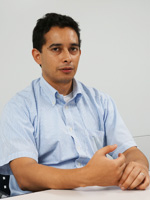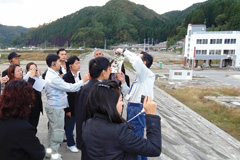InterviewJICA-RI Focus Vol.37 - Interview with Research Fellow Oscar A. Gomez
2016.12.09
When addressing crisis situations that demand humanitarian assistance, such as conflict, natural disaster, and infectious diseases, a more effective continuum of relief, reconstruction, prevention, and development has been a permanent, unresolved concern. We asked JICA Research Institute Research Fellow Oscar A. Gomez, who participated in the first World Humanitarian Summit held in Istanbul on May 23 and 24, 2016, about the kind of crisis management that is desirable from the viewpoint of human security.
Profile
Gomez was born in Colombia. After studying chemical engineering and working for the Secretary of Health in the capital city of Bogota, he entered the Graduate School of Environmental Studies at Tohoku University in 2006. Accepting a scholarship from the Japanese government, he joined the International Joint Educational Program in Human Security at the University. When he finished his doctoral program, the 2011 Great East Japan Earthquake struck. From 2011, he began working with United Nations agencies in Latin America and then with the United Nations Development Programme's Human Development Report while serving as a visiting scholar at Doshisha University. He assumed his current position in 2013.

- What was JICA-RI's involvement in the World Humanitarian Summit and what are your impressions of the event?
At the World Humanitarian Summit, we distributed our paper "The Continuum of Humanitarian Crisis Management: Messages for the World Humanitarian Summit," which summarizes the interim results of the research project "Comparative Study of Humanitarian Crisis Management from the Perspective of Bilateral Cooperation Agencies," in which I am involved. Five messages were included (see the link below): 1. Recognize that crisis management is not linear. 2. Transcend the divide of mandates and mindsets. 3. Putting ‘local’ at the center. 4. Prevention starts from crisis Day One. and 5. Consolidate a demand-driven rearrangement of crisis-related global cooperation. The third message was particularly emphasized in the summit's overall recommendations. I felt that there was agreement between our research findings and the summit outcome.
Another notion I felt strongly about was a doubt regarding the distinction between actors involved in humanitarian assistance and actors involved in development assistance; this is also mentioned in the paper. For example, as our fifth message shows, to carry out seamless assistance and ensure effective use of limited resources, it is important to configure a cooperative structure tailored to the type of crisis, be it droughts, conflicts, or natural disasters. The distinction between actors is meaningless for locals affected by a crisis. Nevertheless, there is an extremely clear distinction regarding this in the international arena.
In March 2016, before the World Humanitarian Summit, I participated in the World Conference on Humanitarian Studies in Ethiopia and conducted a small survey about the initiatives of organizations involved in drought assistance in that country. Droughts, unlike earthquakes and hurricanes, do not occur suddenly, so actors provide assistance using their own capacities and comparative advantages regardless of whether their work is labeled as humanitarian assistance or development assistance. I am interested in how these actors can change the international cooperation system in the future.
Development processes always end at some point, but crises will always occur. It is possible that someday in the future, there will be no need for JICA's development cooperation. Still, I think JICA’s crisis management capabilities, rather than development approach, will probably be the most important contribution in decades to come.
- What is the research project "Comparative Study of Humanitarian Crisis Management from the Perspective of Bilateral Cooperation Agencies" about and what are the results?
JICA has included seamless assistance as one of its strategies since 2008, but the meaning of “seamless” and its implications remain unclear. This was evident to me when I was analyzing Japan's Official Development Assistance (ODA) as part of the effort to co-write a chapter on human security for the book "Japan's Development Assistance: Foreign Aid and the Post-2015 Agenda," published to mark the 60th anniversary of Japan's ODA. That was the origin of the idea for this research project. We started the project in 2015 with the objective of clarifying the required policies and systems to achieve JICA's seamless assistance.

Local officials working for the Project on Rehabilitation and Recovery
from Typhoon Yolanda
In the first phase, we clarified the kind of approaches to bilateral assistance that agencies, including JICA, have devised to address humanitarian crises; and in the second phase, we researched six cases: Syria, Timor-Leste, and South Sudan from the standpoint of conflict and the Indian Ocean Earthquake, Typhoon Yolanda in the Philippines, and Hurricane Mitch in Honduras from the standpoint of natural disasters. We plan to publish a book in 2017 and are currently completing the editorial work.
I was in charge of the research on Hurricane Mitch, which occurred in Honduras in 1998. One of the findings was that the intention of the Honduran government to emphasize disaster recovery, reconstruction, and disaster risk reduction was incompatible with the intention of various donors to reduce poverty simultaneously. The budget failed to emphasize disaster risk reduction and management, which was postponed for a decade.
- What is the research project "Human Security in Practice: East Asian Experiences" about and is it making progress?
Although the debate regarding human security has deepened since the concept was proposed in 1994, research on the practice in the field has been inadequate. We began this research project in 2013 with the goal of formulating effective proposals for ensuring human security. This project is expected to last four and a half years through 2018 and is currently in its second phase.
In the first phase, we investigated how the concept of human security has been understood and what the threats to human security are in 11 of the 13 ASEAN Plus Three (Japan, China, and South Korea) countries. We plan to summarize this in one volume and publish it on the website of JICA-RI. I am currently writing a comparative, cross-sectional analysis on various cases for the report.
For the second phase, we are investigating and analyzing specific measures after major crises in order to provide human security on the operational level, and I am in charge of the Great East Japan Earthquake. I concentrated on the issue of external assistance after the earthquake and suggested three categories for the purpose of my analysis: traditional assistance in the form of people, basic goods, and money; nontraditional assistance (specialized aid) for the nuclear accident and other purposes; and non-rejectable aid from individuals, businesses and NGOs.
We learned that with regard to traditional assistance, rescue work and the provision of goods were not sufficiently effective, but nontraditional assistance was effective as it was carried out by specialists in response to special needs.
In crisis management, it is important to emphasize the local aspect by empowering disaster-affected areas and people, and placing donors at the center does not work. It is important for disaster-affected areas and people to have the right to refuse assistance they do not need. The case of non-official assistance is different because it cannot be rejected. Therefore, in this case, it is more beneficial if people can adapt non-rejectable aid to the needs of the disaster-affected area.
During the Great East Japan Earthquake, thanks to the intermediary role of the humanitarian assistance agencies such as the Japanese Red Cross Society and Japan Platform, it was possible to match assistance to the needs of the disaster-affected area by coordination and making space for local arrangements.
- What is the relationship between human security and "quality growth?"
Environmental problems have a wide range of sources and implications, including economic, technological, political and social. I learned about the four big pollution diseases of Japan when studying environmental management in Colombia and became very interested in them. Then, at Tohoku University, I researched about these pollution diseases and international cooperation and encountered the term "human security" for the first time. I realized that I can analyze not only pollution but also other issues by focusing on human security, so I researched the theory and practice of human security in my doctoral program. In 2011, the Great East Japan Earthquake occurred as I was completing my studies, so I decided to start researching disasters from the human security perspective.

Thai administrative officials receive training at a site destroyed by the
Great East Japan earthquake
One experience from the earthquake that left a strong impression on me was Sendai citizens forming lines to hoard food and other items right after the disaster. Immediately going to buy food after a disaster is a sight I did not expect. Media sources later announced the scarcity of food, but an investigation in Sendai City revealed that fewer than 10 percent of the city’s population had received food at shelters. To put it the other way around, more than 90 percent managed to subsist without provisions from shelters. I advanced research concerning this issue and later published a paper titled "The Emergence of Food Panic: Evidence from the Great East Japan Earthquake," wherein I describe the dynamics of food provision after the disaster.
Staying true to my initial engineering background, I am committed to researching actual cases while recognizing that theoretical and philosophical elements are essential. Thus, my approach is to maintain a constant balance between the two.
I think "quality growth," which is advocated in Japan's Development Cooperation Charter, is extremely important. If people are protected from threats as economic growth takes place, I have no criticism to make. However, if you look at history, there are always people negatively impacted by growth. In that regard, I suppose human security is about protecting those vulnerable populations left behind, with or without growth. Of course, it is ideal for growth and human security to advance in tandem.
- How can research contribute to crisis countermeasures?
A certain amount of knowledge is needed to prevent crises. For example, in the Honduras case that I analyzed, many people lost their lives from landslides and floods due to Hurricane Mitch. One of the causes appeared to be that the country had not stored up enough knowledge about landslides. It is important to improve the capacity of the government and community, but from a long-term perspective, it is also quite important to consider how to develop specialized human resources for this kind of crisis prevention. Unfortunately, it seems that this kind of research and long-term commitment is not always emphasized.
JICA conducts training for government staff in developing countries, but bureaucrats in such countries are in a weaker position than those in Japan, partly because they are sometimes replaced altogether when the administration changes. It is quite difficult to keep a person with specialized knowledge in a position requiring good pay, benefits and other entitlements. I believe we need to know more about how people with specialized knowledge can better influence the societies of developing countries to improve capacity development.
An interesting case to follow is the experience of the Science and Technology Research Partnership for Sustainable Development (SATREPS), which JICA is carrying out jointly with the Japan Science and Technology Agency. This program includes research on infectious diseases and disaster risk reduction; therefore, it offers the opportunity to understand how expert knowledge can be useful when addressing threats that can turn into crises. Conducting follow-up studies on how people benefitting from this program employ acquired knowledge 5, 10, 15, or 20 years later can provide hints. I intend to conduct research on how knowledge can contribute to the field of crisis prevention and how specialization can be developed and accumulated in each society to actually impact the country's policies.

事業事前評価表(地球規模課題対応国際科学技術協力(SATREPS)).国際協力機構 地球環境部 . 防災第一チーム. 1.案件名.国 名: フィリピン共和国.

事業事前評価表(地球規模課題対応国際科学技術協力(SATREPS)).国際協力機構 地球環境部 . 防災第一チーム. 1.案件名.国 名: フィリピン共和国.

事業事前評価表(地球規模課題対応国際科学技術協力(SATREPS)).国際協力機構 地球環境部 . 防災第一チーム. 1.案件名.国 名: フィリピン共和国.

事業事前評価表(地球規模課題対応国際科学技術協力(SATREPS)).国際協力機構 地球環境部 . 防災第一チーム. 1.案件名.国 名: フィリピン共和国.

事業事前評価表(地球規模課題対応国際科学技術協力(SATREPS)).国際協力機構 地球環境部 . 防災第一チーム. 1.案件名.国 名: フィリピン共和国.
scroll